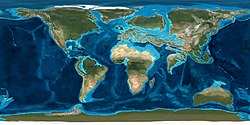Loading AI tools
First age of the Eocene Epoch From Wikipedia, the free encyclopedia
In the geologic timescale the Ypresian is the oldest age or lowest stratigraphic stage of the Eocene. It spans the time between 56 and 47.8 Ma, is preceded by the Thanetian Age (part of the Paleocene) and is followed by the Eocene Lutetian Age. The Ypresian is consistent with the Lower Eocene (Early Eocene).
| Ypresian | |||||||||||||
|---|---|---|---|---|---|---|---|---|---|---|---|---|---|
 Earth ~50 mya | |||||||||||||
 | |||||||||||||
| Chronology | |||||||||||||
| |||||||||||||
| Formerly part of | Tertiary Period/System | ||||||||||||
| Etymology | |||||||||||||
| Name formality | Formal | ||||||||||||
| Usage information | |||||||||||||
| Celestial body | Earth | ||||||||||||
| Regional usage | Global (ICS) | ||||||||||||
| Time scale(s) used | ICS Time Scale | ||||||||||||
| Definition | |||||||||||||
| Chronological unit | Age | ||||||||||||
| Stratigraphic unit | Stage | ||||||||||||
| First proposed by | Dumont | ||||||||||||
| Time span formality | Formal | ||||||||||||
| Lower boundary definition | Strong negative anomaly in δ13C values at the PETM[3] | ||||||||||||
| Lower boundary GSSP | Dababiya section, Luxor, Egypt[3] 25.5000°N 32.5311°E | ||||||||||||
| Lower GSSP ratified | 2003[3] | ||||||||||||
| Upper boundary definition | FAD of the calcareous nannofossil Blackites inflatus | ||||||||||||
| Upper boundary GSSP | Gorrondatxe section, Western Pyrenees, Basque Country, Spain 43.3796°N 3.0143°W | ||||||||||||
| Upper GSSP ratified | April 2011[4] | ||||||||||||
The Ypresian Age begins during the throes of the Paleocene–Eocene Thermal Maximum (PETM). The Fur Formation in Denmark, the Messel shales in Germany, the Oise amber of France and Cambay amber of India are of this age. The Eocene Okanagan Highlands are an uplands subtropical to temperate series of lakes from the Ypresian.[5][6][7]
The Ypresian is additionally marked by another warming event called the Early Eocene Climatic Optimum (EECO). The EECO is the longest sustained warming event in the Cenozoic record, lasting about 2–3 million years between 53 and 50 Ma. The interval is characterized by low oxygen-18 isotopes,[8][9][10] high levels of atmospheric pCO2,[11][12] and low meridional thermal gradients.[13] Biodiversity has been reported to have been significantly impacted by the conditions prevalent during the EECO. For instance, there were biotic turnovers among marine producers such as calcareous nannofossils among others etc.[14][15]
The Ypresian Stage was introduced in scientific literature by Belgian geologist André Hubert Dumont in 1850. The Ypresian is named after the Flemish city of Ypres in Belgium (spelled Ieper in Dutch). The definitions of the original stage were totally different from the modern ones.[16] The Ypresian shares its name with the Belgian Ieper Group (French: Groupe d'Ypres), which has an Ypresian age.
The base of the Ypresian Stage is defined at a strong negative anomaly in δ13C values at the PETM. The official reference profile (GSSP) for the base of the Ypresian is the Dababiya profile near the Egyptian city of Luxor.[17] Its original type section was located in the vicinity of Ieper.
The top of the Ypresian (the base of the Lutetian) is identified by the first appearance of the foraminifera genus Hantkenina in the fossil record.
The Ypresian Stage overlaps the upper Neustrian and most of the Grauvian European Land Mammal Mega Zones (it spans the Mammal Paleogene zones 7 through 10.[18]), the Wasatchian and lower and middle Bridgerian North American Land Mammal Ages, the Casamayoran South American Land Mammal Age and the Bumbanian and most of the Arshantan Asian Land Mammal Ages. It is also coeval with the upper Wangerripian and lowest Johannian regional stages of Australia and the Bulitian, Penutian, and Ulatisian regional stages of California.
Seamless Wikipedia browsing. On steroids.
Every time you click a link to Wikipedia, Wiktionary or Wikiquote in your browser's search results, it will show the modern Wikiwand interface.
Wikiwand extension is a five stars, simple, with minimum permission required to keep your browsing private, safe and transparent.